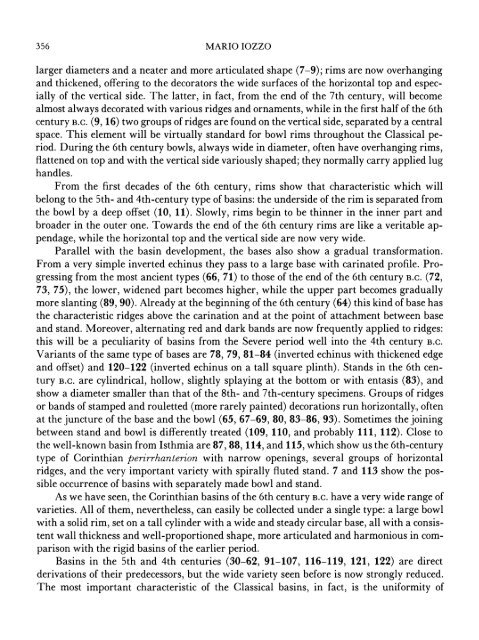f - The American School of Classical Studies at Athens
f - The American School of Classical Studies at Athens
f - The American School of Classical Studies at Athens
Create successful ePaper yourself
Turn your PDF publications into a flip-book with our unique Google optimized e-Paper software.
356 MARIO IOZZO<br />
larger diameters and a ne<strong>at</strong>er and more articul<strong>at</strong>ed shape (7-9); rims are now overhanging<br />
and thickened, <strong>of</strong>fering to the decor<strong>at</strong>ors the wide surfaces <strong>of</strong> the horizontal top and espec-<br />
ially <strong>of</strong> the vertical side. <strong>The</strong> l<strong>at</strong>ter, in fact, from the end <strong>of</strong> the 7th century, will become<br />
almost always decor<strong>at</strong>ed with various ridges and ornaments, while in the first half <strong>of</strong> the 6th<br />
century B.C. (9, 16) two groups <strong>of</strong> ridges are found on the vertical side, separ<strong>at</strong>ed by a central<br />
space. This element will be virtually standard for bowl rims throughout the <strong>Classical</strong> pe-<br />
riod. During the 6th century bowls, always wide in diameter, <strong>of</strong>ten have overhanging rims,<br />
fl<strong>at</strong>tened on top and with the vertical side variously shaped; they normally carry applied lug<br />
handles.<br />
From the first decades <strong>of</strong> the 6th century, rims show th<strong>at</strong> characteristic which will<br />
belong to the 5th- and 4th-century type <strong>of</strong> basins: the underside <strong>of</strong> the rim is separ<strong>at</strong>ed from<br />
the bowl by a deep <strong>of</strong>fset (10, 11). Slowly, rims begin to be thinner in the inner part and<br />
broader in the outer one. Towards the end <strong>of</strong> the 6th century rims are like a veritable ap-<br />
pendage, while the horizontal top and the vertical side are now very wide.<br />
Parallel with the basin development, the bases also show a gradual transform<strong>at</strong>ion.<br />
From a very simple inverted echinus they pass to a large base with carin<strong>at</strong>ed pr<strong>of</strong>ile. Pro-<br />
gressing from the most ancient types (66, 71) to those <strong>of</strong> the end <strong>of</strong> the 6th century B.C. (72,<br />
73, 75), the lower, widened part becomes higher, while the upper part becomes gradually<br />
more slanting (89, 90). Already <strong>at</strong> the beginning <strong>of</strong> the 6th century (64) this kind <strong>of</strong> base has<br />
the characteristic ridges above the carin<strong>at</strong>ion and <strong>at</strong> the point <strong>of</strong> <strong>at</strong>tachment between base<br />
and stand. Moreover, altern<strong>at</strong>ing red and dark bands are now frequently applied to ridges:<br />
this will be a peculiarity <strong>of</strong> basins from the Severe period well into the 4th century B.C.<br />
Variants <strong>of</strong> the same type <strong>of</strong> bases are 78, 79, 81-84 (inverted echinus with thickened edge<br />
and <strong>of</strong>fset) and 120-122 (inverted echinus on a tall square plinth). Stands in the 6th cen-<br />
tury B.C. are cylindrical, hollow, slightly splaying <strong>at</strong> the bottom or with entasis (83), and<br />
show a diameter smaller than th<strong>at</strong> <strong>of</strong> the 8th- and 7th-century specimens. Groups <strong>of</strong> ridges<br />
or bands <strong>of</strong> stamped and rouletted (more rarely painted) decor<strong>at</strong>ions run horizontally, <strong>of</strong>ten<br />
<strong>at</strong> the juncture <strong>of</strong> the base and the bowl (65, 67-69, 80, 83-86, 93). Sometimes the joining<br />
between stand and bowl is differently tre<strong>at</strong>ed (109, 110, and probably 111, 112). Close to<br />
the well-known basin from Isthmia are 87, 88, 114, and 115, which show us the 6th-century<br />
type <strong>of</strong> Corinthian perirrhanterion with narrow openings, several groups <strong>of</strong> horizontal<br />
ridges, and the very important variety with spirally fluted stand. 7 and 113 show the pos-<br />
sible occurrence <strong>of</strong> basins with separ<strong>at</strong>ely made bowl and stand.<br />
As we have seen, the Corinthian basins <strong>of</strong> the 6th century B.C. have a very wide range <strong>of</strong><br />
varieties. All <strong>of</strong> them, nevertheless, can easily be collected under a single type: a large bowl<br />
with a solid rim, set on a tall cylinder with a wide and steady circular base, all with a consis-<br />
tent wall thickness and well-proportioned shape, more articul<strong>at</strong>ed and harmonious in com-<br />
parison with the rigid basins <strong>of</strong> the earlier period.<br />
Basins in the 5th and 4th centuries (30-62, 91-107, 116-119, 121, 122) are direct<br />
deriv<strong>at</strong>ions <strong>of</strong> their predecessors, but the wide variety seen before is now strongly reduced.<br />
<strong>The</strong> most important characteristic <strong>of</strong> the <strong>Classical</strong> basins, in fact, is the uniformity <strong>of</strong>

















